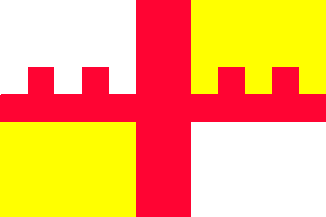 Shipmate Flagchart : http://www.flagchart.net
Shipmate Flagchart : http://www.flagchart.net
adopted 3 Sep 1991

Last modified: 2018-12-15 by rob raeside
Keywords: grootegast | tasman |
Links: FOTW homepage |
search |
disclaimer and copyright |
write us |
mirrors
 Shipmate Flagchart : http://www.flagchart.net
Shipmate Flagchart : http://www.flagchart.net
adopted 3 Sep 1991
![[Grootegast Coat of Arms]](../images/n/nl-gr)gg.gif) image from the Grootegast municipal
website.
image from the Grootegast municipal
website.
The arms are: argent a castle gules on a terrace vert.
![[Grootegast old flag]](../images/n/nl-gr_gg.gif) by Jarig Bakker, 7 Apr 2005
by Jarig Bakker, 7 Apr 2005
Grootegast old municipal flag: Horizontal stripes of white - red - green
- white; white and red embattled; green and white wavy.
The field is white, based on the field of the municipal arms; in white
two colors (red and green) - the embattlements are derived from the arms
and symbolize the villages in the municipality. Green is derived from the
arms too; the waves remind of the old watercourse of the Hoendiep.
Flag adopted 3 Sep 1978
Source: Vexilla Nostra no. 102 (1979): 39 (letter by the municipality)
After the merger with Oldekerk in 1990 the new municipality of Grootegast
adopted a new flag.
Jarig Bakker, 7 Apr 2005